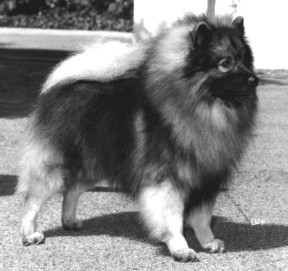
Am. Ch. Flakkee Jackpot ROMX HOF (winner of 45 Best in Shows)
 Am. Ch. Flakkee Jackpot ROMX HOF (winner of 45 Best in Shows) |
Size, Proportion, Substance
The Keeshond is a medium-sized, square-appearing, sturdy dog, neither coarse nor
lightly made. The ideal height of fully matured dogs when measured from top of
withers to the ground is 18 inches for males and 17 inches for bitches -- a one inch
variance either way is acceptable. While correct size is very important, it should
not outweigh that of type.
Head
Eyes -- Eyes should be dark brown in color, of medium size, almond shaped,
set obliquely and neither too wide apart nor too close together. Eye rims are black.
Faults: Round and/or protruding eyes or eyes light of colour.
Ears -- Ears should be small, triangular in shape, mounted high on head and
carried erect. Size should be proportionate to the head -- length approximating the
distance from the outer corner of the eye to the nearest edge of the ear.
Fault: Ears not carried erect when at attention.
Skull -- The head should be well-proportioned to the body and wedge-shaped
when viewed from above -- not only the muzzle, but the whole head should give this
impression when the ears are drawn back by covering the nape of the neck and the
ears with one hand. Head in profile should exhibit a definite stop.
Faults: Apple head or absence of stop.
Muzzle -- Of medium length, neither coarse nor snipey, and well proportioned to the skull.
Mouth -- The mouth should be neither overshot nor undershot. Lips should be
black and closely meeting - not thick, coarse or sagging - and with no wrinkle at
the corner of the mouth.
Faults: Overshot, undershot or wry mouth.
Teeth -- The teeth should be white, sound and strong meeting in a scissors
bite.
Fault: Misaligned teeth.
Tail -- The tail should be moderately long and well feathered, set on high and
tightly curled over the back. It should lie flat and close to the body. The tail
must form a part of the "silhouette" of the dog's body, rather than give the appearance
of an appendage.
Fault: Tail not lying close to the back.
Forequarters -- Forelegs should be straight seen from any angle. Pasterns are strong with a slight slope. Legs must be of good bone in proportion to the overall dog. Shoulder to upper arm angulation is between slight to moderate.
Hindquarters -- Angulation in rear should be between slight to moderate to compliment the forequarters, creating balance and typical gait. Hindquarters are well muscled with hocks perpendicular to the ground.
Feet -- The feet should be compact, well rounded, catlike. Toes are nicely arched, with black nails.
Color and Markings
A dramatically marked dog, the Keeshond is a mixture of gray, black and cream.
This coloration may vary from light to dark. The hair of the outer coat is black
tipped, the length of the black tips producing the characteristic shading of color.
Puppies are often less intensely marked. The under coat is very pale gray or cream,
never tawny.
Ruff, Shoulders and "Trousers" -- The color of the ruff and "trousers" is lighter than that of the body. The shoulder line markings of light gray must be well defined.
Tail -- The plume of the tail is very light in color when curled on the back, and the tip of the tail should be black.
Legs and Feet -- Legs and feet are cream.
Faults: Pronounced white markings. Black markings more than halfway down
the foreleg, penciling excepted. White foot or feet.
Very Serious Faults: Entirely black or white or any solid color: any
pronounced deviation from the color as described.
Gait
The distinctive gait of the Keeshond is unique to the breed. Dogs should move
boldly and and keep tails curled over the back. They should move cleanly briskly;
the movement should be straight and sharp with reach and drive between slight
to moderate.
Temperament
Temperament is of primary importance. The Keeshond is neither timid nor aggressive
but, instead, is outgoing and friendly with both people and other dogs. The
Keeshond is a lively, intelligent, alert and affectionate companion.
Home | FAQ | About Us | News | Our dogs | Ancestors | Puppies | Older dogs | Fun | Genetics | Articles | Links | Contact | Site map |